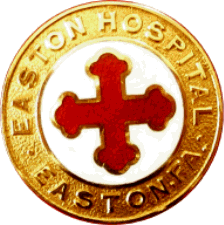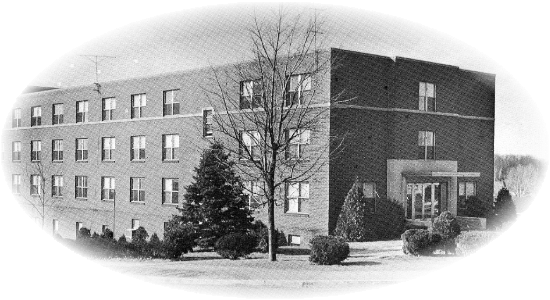A Brief History of Easton Hospital and the School of Nursing
1890
A group of churchwomen, the King's Daughters, galvanized by Dr. Anna M. McAllister, began a campaign to build the first hospital in Easton. A fundraiser brought in $9,443.52.
The Hospital's charter called for a Board of Trustees, consisting of 15 women. Mrs. Emma Pfatteicher was elected first president of the Board and held that position for 21 years. Physicians were elected to the Medical Staff by the Board. The Board's power was absolute.
A property on Wolf Street was bought for $7,000. The large wooden residence was renovated into the first Easton Hospital with 11 beds, five attending physicians (Dr. Charles Collmar, who became the Hospital's first surgeon, Dr. Henry Michler, Dr. W. W. Evans, Dr. Edgar M. Green, and Dr. Robley Walter), four consulting physicians (Drs. Traill Green, James Cavanaugh, Isaac Ott, and J.S. Hunt), and one nurse. The Hospital officially opened on November 20.
Sister Marie Sowa, a Lutheran Deaconess, was the first Superintendent of the Hospital and Director of the School of Nursing. The nurses did not receive a salary, but their housing at the Mary J. Drexel Home in Philadelphia was compensated. Until 1897 the services cost $212.50 per nurse per year. Sister Marie and her associates taught nursing care, as well as the domestic chores which students performed at that time during their 12-hour shifts. The deaconesses ended their relationship at the hospital in 1918 and Sister Marie Sowa retired after 21 years of service.
1900
The School of Nursing at Easton Hospital officially opened with Grace Keller as the first student nurse. When the school opened, the nursing program was one year; then, it expanded to two years. There was no graduating class in 1907 because the school expanded to a three year program and there was no one ready to graduate with the change.
Nursing education of the time was based on the Florence Nightingale model, consisting principally of three years of hard clinical and domestic work, associated with strict moral and academic discipline. A reflection of this was the 6:30 am chapel exercises held at the Easton Hospital by the deaconesses for the student nurses. These were continued until around 1956.
In 1914, 15 years after Grace Keller enrolled, students were given $8.00 a month for uniforms and textbooks, two weeks' vacation, two free hours daily, one free afternoon weekly and freedom every second Sunday.
There was a steady increase in the number of medical and surgical patients admitted. In this era, most of the medical problems that brought people to the Hospital were rheumatism, typhoid fever, and the pneumonias.
Early specialties were eye, ear, nose, and throat; obstetrics; and anesthesia. Removal of cataracts, eye muscle corrections, and extraction of foreign bodies from the eye were the most common eye operations. Operations for middle ear infections and mastoiditis were frequent.
During the year, 387 patients were treated.
1920-1926
The Hospital faced three chronic problems after the first war: a shortage of nurses, inadequate quarters and effects of inflation. To improve situations, remuneration to the students increased to $10 a month and graduate nurses were employed to augment staff. The training school was reorganized and accredited by the Pennsylvania State Board of Nursing.
1929
The men enlarged the Board to include ten more men to deal with the construction of a new hospital.
The Women's Board was formed. Mrs. E. Brand Beacham was its first President. It supervised the School of Nursing. The Women's Board has remained a strong, beneficial influence and a source of special financial support to the Hospital.
A State Cancer Clinic was established at the Hospital.
1930
Dedication of the new Easton Hospital and Nurses' Home in Wilson Borough took place. (In 1952, the Nurses' Home was re-named "Meuser Hall," in honor of Fred Meuser, a Trustee and active supporter of the Hospital and its mission for many years.)
Enrollment of nurses grew from 12 to 52. Education requirements increased from one year of certified high school work to graduation from high school. The monthly stipend was reduced from $10 to $5. Students spent 12 hours on duty at night and attended classes during the day. They were expected to provide most of the nursing service and a large part of the maid service. Mabel Wilson had been the director at the time and she recommended employment of more general staff nurses to ease the burden on the students. The student allowance was then reduced to $2 and eliminated in 1939.
1940-1945
During and after World War II, many changes were made: changes to the nursing educational system: there was one instructor and only one class of nurses where there had been two. The 12 hour shifts were decreased to 8. Tuition of $130 was adopted and due to the economy; the Hospital found it difficult to compete for labor and graduate nurses. In 1943, the Pennsylvania State Board of Nursing Examiners removed the Hospital from its accredited list of Training schools, but was reinstated in 1944.
Changes for the physician's: the system of internships gave way to residencies at hospitals, which meant considerably more training became necessary in both medical and surgical specialties. New York University began an affiliation with the Hospital to send residents here in the late 40s and early 50s. This program was helpful in shifting Easton from a small community hospital to a teaching hospital.
Dr. George Barrett began a program to develop the present Department of Urology.
The war had depleted the hospital staff seriously. This led to the development of ancillary services, such as Housekeeping and Central Services, which freed the nurses of many non-professional duties, allowing them to concentrate more fully on patient care.
1947
Helen Morris became Director of the School of Nursing. Her professionalism, her high standards, and her concern for students made her a role model for nursing classes.
1950
The cornerstone for the West Wing was laid. In 1951, the Easton Hospital School of Nursing was inspected by a representative of the National League of Nursing and granted provisional accreditation for five years. With improved administrationa and faculty and the expanding housing facilities, there was an increas in the number of applicants and students. 1952, a new and larger nurses' residence was dedicated (to be known years later as the Clinic Building).
1957-1964
The School of Nursing faced problems with obtaining accreditation and competent faculty members. One solution was an arrangement with Penn State University faculty to teach anatomy, physiology, chemistry, microbiology, sociology, and psychology. The Women's Board began subsidizing graduate education courses for the Nurses' School faculty and other graduate nurses on the Hospital staff. By 1962, there were 17 members on the faculty. Five were from Penn State. Despite the curriculum revision and more students passing State Board exams, the State Board continued it's provisional approval until after its 1963 inspection.
The school did not admit students for a year during this transition, therefore there was not a graduating class of 1964. In 1963, Virginia McIlroy became the Director of Nursing Education. Under her guidance, the School of Nursing would attain the highest of academic standards and performance, and again be fully approved by the State Board of Education and Licensure. In 1960 the School of Nursing was ranked last but within a few years, it was raised to rank #30 out of 106 nursing schools in Pennsylvania.
1965-1975
During this time, several changes within the Hospital were taking place:
Dr. William Johnson, Chairman of the Building and Equipment committee, as well as Director of the Department of Radiology, poured his considerable energies into acquiring updated equipment for the Hospital.
The Short Procedure Unit was opened, as well as a ten-bed Surgical Intensive Care Unit.
The nurses formed a Nurses Professional Association to carry out collective bargaining with the Hospital administration. 80% of them joined the Pennsylvania Nurses Association.
The graduating class of 1969 admitted the first male students: Lawrence Cawthon, Hugh Daley and George Gemberling. (James Pene started with the class, but did not graduate)
In 1968, the Administrator of the Hospital joined the advisory committee of the associate degree program at the Northampton County Area Community College (NCACC). He spoke of the need for an "orderly transition" of nursing education from hospital to colleges. In 1969 he recommended the school be closed as it was "too expensive" and "no longer essential to the future welfare of the hospital and its patients". The Board of Trustees disagreed at the time. The 25 students of the Class of 1970 passed their State Board examinations with only one subject failure.
In 1972 the school obtained reaccreditation by the National League for Nursing. Within the years of 1973-1975, the cirriculum was revised, the traditional structured systems approach to care was abandoned for problem-solving methods based on scientific principles. The concept of the patient as a member of a family in a hospital, at home and in the community was made an integral part of every course. Graduates surpassed national averages in three of the five tests on the State Board Examinations. However, a decision had been made and voted on by the executive committee of the Board of Trustees to close the school.
On August 21, 1975, the School of Nursing officially closed.








